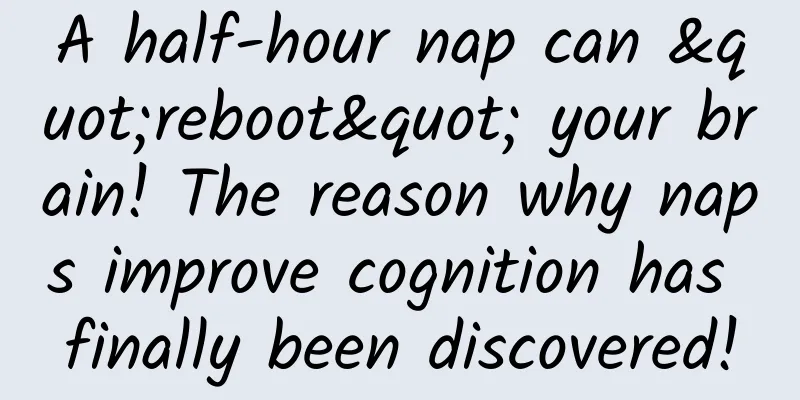A half-hour nap can "reboot" your brain! The reason why naps improve cognition has finally been discovered!

|
Perhaps, we have all had that feeling after lunch: "The head is filled with lead, and the eyelids are glued shut by 502", and we often suspect that we are "fighting wits and courage" with Zhou Gong. But don't rush to blame yourself, this is not a problem of laziness, but our brain is holding up a "small flag" to beg for mercy: "Please, give me a break!" Unfortunately, many people choose to ignore this signal and try to get through the afternoon, resulting in a complete drop in efficiency and a complete breakdown in status. In fact, the ancients had a brilliant idea about naps. Wang Anshi wrote in a poem: "Fine books harm old eyes, long mats are good for sleep. Lean on the mat and take a rest, throw away the books and return to youth." Bai Juyi said even more bluntly: "Lying sideways in the sun, a good sleep will cure all diseases." Both Wang Anshi's "return to youth" and Bai Juyi's "cure all diseases", they all show the wonderful effect of naps. You may have heard that napping helps the brain become more awake and work more efficiently. This saying has been around for a century! But what is the neural mechanism behind it? Recently, the latest research published in the top journal Science gave the answer. The researchers conducted multi-electrode recording experiments in the brains of macaques to observe changes in neural activity in the visual cortex and dorsolateral prefrontal cortex before and after sleep. The study found that a short sleep of only 30 minutes can desynchronize neural activity in the cerebral cortex, improve information encoding capabilities, and thus improve cognitive performance. Moreover, this process can be simulated by low-frequency electrical stimulation (4Hz). The principle is that sleep prompts the local synaptic connections in the brain to readjust and form an asymmetric inhibition mechanism, thereby helping the brain to "restart" and optimize information processing. In addition, the study also found that stimulating the visual cortex with low-frequency electrical stimulation at 4 Hz can simulate the beneficial effects of sleep on neural networks and perceptual performance. Simulations of large-scale neural network models showed that asymmetric inhibition of local cortical synapses is highly consistent with the changes in neural activity observed after sleep. It seems that a short 30-minute nap can give the brain a magical "restart", improve information encoding ability, and optimize cognitive performance. So, for those friends who are still struggling with whether to listen to the call of the body and enjoy a short nap, science has given the answer: don't hesitate, give yourself a chance to recharge! Healthy nap, pay attention to these points 1. Keep warm during naps When it is cold, you must take good precautions to keep warm during your afternoon nap. This is because the body temperature drops during the afternoon nap, and the body's resistance also weakens, which greatly increases the probability of cold air invading. 2. Don’t take a nap right after eating Many people have a short lunch break, and taking a break right after lunch has become the norm. Doctors recommend that after lunch, try to take a walk in the sun for 10-20 minutes to relieve the feeling of fullness after a meal, promote digestion, and give the stomach some rest time. Then take a nap. Just after lunch, the stomach is full of food, and the digestive system is the busiest at this time. If you take a nap at this time, it will affect the digestion of the gastrointestinal tract, hinder the absorption of food, and even cause food reflux. If this continues for a long time, it will cause lesions in the stomach and have a serious impact on the body's digestive function. The quality of the nap will also be affected. 3. Use a higher cushion when taking a nap Lying on the desk for a nap will prevent the body from stretching, which will lead to poor blood circulation and increase blood vessel pressure. Lying on the arms for sleep will also cause compression of nerves in many parts of the body, often causing anxiety during naps and difficulty falling asleep. At the same time, the posture of lying on the desk puts greater pressure on the cervical spine, lumbar spine and back, which can easily cause damage to these parts in the long run. Doctors recommend that office workers should try to lie on their backs on a chair during lunch breaks. If conditions do not allow, they should try to raise their heads and lie on soft pillows and mats for a nap. 4. Massage your neck, waist and back after a nap It is better to wake up slowly after a nap. Waking up suddenly will cause blood pressure fluctuations and dizziness. Doctor Chen Luquan said that you can do a simple massage after waking up. For example, a dry face massage on the face can promote blood circulation; after the massage, the neck, waist and back can be better relieved, allowing the body's functions to gradually "wake up". |
<<: It’s cold, is it good to wear socks to sleep?
>>: The "sweet egg yolk" that grows on trees is high in antioxidants, nutritious and delicious
Recommend
What are the benefits of stinky tofu? Where is the most famous stinky tofu?
Stinky tofu smells bad but tastes good. After fer...
Do you know? Kaimen┋Five key points of food safety, remember them
Writing expert: Zhang Yajing, chief nutritionist ...
Are breast enhancement creams harmful? Learn to use it correctly in the future
Nowadays, there are many breast enhancement produ...
What are the reasons for a hysterectomy?
Subtotal hysterectomy is the abbreviation of subt...
40-year-old menstruation suddenly becomes less and less
Under normal circumstances, every female friend w...
What causes lower abdominal distension and pain during pregnancy?
Once a woman becomes pregnant, she will experienc...
Excretion of white tofu residue in the uterus
Key reminder: The white callous-like substance di...
Breast enhancement method with peanuts, red dates and astragalus
Poor breast development is a big problem that giv...
How to avoid slipping when fishing with earthworms? Tips for fishing crucian carp with earthworms
I believe that anyone who has used earthworms to ...
What should women put in the bath?
Taking a bath is something that must be done ever...
Breasts become smaller after weaning the child_Breasts become smaller after breastfeeding_Breasts become smaller after weaning
In order to provide their babies with more nutrit...
How can I know if I am pregnant?
Some people are more confused in life, which make...
Congenital clubfoot, little knowledge you need to know -
Patient: Doctor, can you see whether my baby has ...
Can pregnant women eat a lot of pumpkin seeds?
Pumpkin can be used to cook dishes on the table. ...
The difference between the second and third generation of test tube
In vitro fertilization has become a medical techn...









